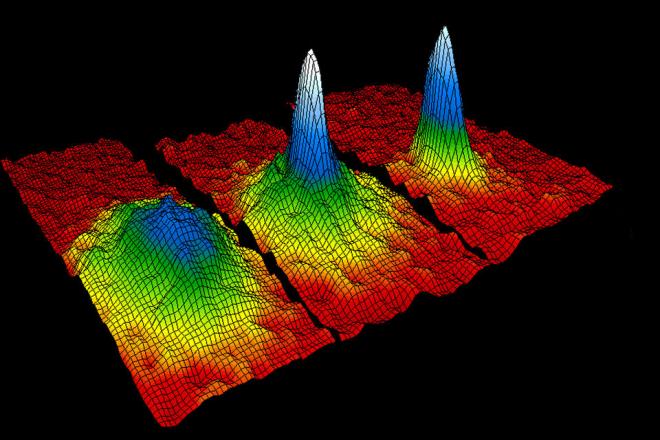Bose Einstein condensate may reveal supersolid’s secrets
Dr. Blair Blakie and Dr. Danny Baillie at the University of Otago used NeSI computing resources to support a paper recently published in Physical Review Letters. The findings from this research were featured in Ars Technica, an online technology publication. Written by Chris Lee, the below article first appeared in Ars Technica on 29 November 2018.
- - - - - - - - - - -
Bose Einstein condensates (BECs) have been around for more than 20 years now. One of the best applications of the BEC, it turns out, is as a tool to explore other quantum things, like solids—yes, the properties of solids are determined by quantum mechanics.
Among those solids is a controversial and possibly nonexistent theoretical one: the supersolid. Now, a pair of theoretical physicists from the University of Otago, Dr. Danny Baillie and Dr. Blair Blakie, has shown that a recently observed BEC “droplet” state may be a way to create a supersolid-like material. That may lead to a way to explore the properties of a supersolid without the difficulties associated with conventional materials.
Bose Einstein condensates
A BEC is a state of matter that requires a specific type of particle. Essentially, the particle world is divided in two: you are either a fermion or a boson. Fermions don’t like each other, so they stack themselves in order of energy, from low to high. Any two fermions that are within touching distance of each other must be different. That might mean different energies, or different spins, or some other property, but they must be different. Pretty much everything is made of fermions, and this stacking is what makes the Universe the way it is.
Bosons are different. Bosons will happily get together and party in the same state. Not only do they not mind having the same state, they love it. If a couple of bosons find themselves in the same state, they will immediately call all their friends and try to get them to join in. And if the bosons have a way to shed enough energy, they will. The result is that it's relatively easy to create a very cold gas of bosons that are all in exactly the same quantum state, called a BEC.
However, not all bosons and BECs are the same. Although the bosons love to be in the same state, most bosons are composite particles, with some of their components fermions. As a result, there are also forces at work trying to drive atoms out of the BEC. The relative strength between the attraction that pulls the BEC together and the repulsive forces that try to blow it apart is something that is under experimental control.
Exploring weird solids
One of the slightly weirder observations of BECs is that certain types of BEC will form arrays of droplets when the conditions are right. We've seen them form a series of evenly spaced globs of relatively high density, but we don't know why they do this. We also don't know what properties these droplets have.
In a reasonably thorough exploration of the phenomena, a pair of theoretical physicists has answered some of these questions. First, droplet formation represents a balance of forces. As we said above, the attractive forces pull the BEC together as the repulsive forces push it apart. For the types of BECs that form droplets, the repulsive forces are not just a function of the density but also the atomic number. A small number of atoms can huddle together nice and close. That number cannot grow very large, though, as that would drive atoms away. That means the BEC forms a number of high-density droplets that all repel each other. Throw in the confines of the trap that controls the BEC, and a nice regular 2D array of droplets emerges.
The researchers wondered if the droplets are really still part of the same BEC. The thing that makes a BEC a single entity is a kind of collective behavior among its atoms. However, that collective behavior requires that the different BEC droplets be connected. That connection takes the form of atoms moving among them.
The researchers showed that if the trap pressed the droplets close together, atoms are regularly transferred among the different droplets, which would allow the BEC to retain its collective behavior.
But critically, they found that under these conditions, the BEC would resemble something called a supersolid. As the droplets move farther apart, atoms can’t move between the droplets anymore. At that point, the BEC doesn’t resemble a supersolid anymore.
The supersolid transition is important because supersolids are still controversial. Supersolids are, well, solid. That is, they retain their shape like conventional solids. But they also do weird things like slide along surfaces without friction, for instance. There have been several experimentalists that claim to have observed the supersolid state, but none of the experiments have been clear enough to make the claim unequivocal.
Here, we have a tool to explore the supersolid form and its phase transition in detail: a clean environment where the state’s properties can be mapped out thoroughly. That should make it easier to refute or support experimental claims in more traditional solid state physics experiments.
Physical Review Letters, 2018, DOI: 10.1103/PhysRevLett.121.195301.
---------------------
Do you have an example of how NeSI platforms have supported your work? We’re always looking for projects to feature as a case study. Get in touch by emailing support@nesi.org.nz.







